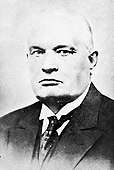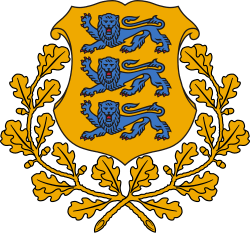Konstantin Päts
Konstantin Päts (Estonian pronunciation: [ˈkons.tɑnʲ.tin ˈpætʲs]; 23 February [O.S. 11 February] 1874[1] – 18 January 1956) was the most influential politician of interwar Estonia, and served five times as the country's head of government. He was one of the first Estonians to become active in politics and started an almost 40-year political rivalry with Jaan Tõnisson, first through journalism with his newspaper Teataja, later through politics. He was condemned to death during the 1905 Revolution, but managed to flee first to Switzerland, then to Finland, where he continued his literary work. He returned to Estonia, but had to spend time in prison in 1910–1911.
Konstantin Päts | |
|---|---|
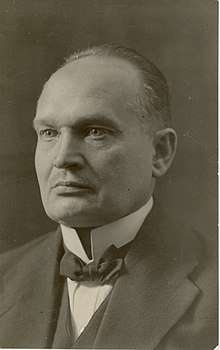 | |
| 1st President of Estonia | |
| In office 24 April 1938 – 23 July 1940 | |
| Prime Minister | Kaarel Eenpalu as Acting Prime Minister Kaarel Eenpalu Jüri Uluots Johannes Vares[Note 1] |
| Succeeded by | Jüri Uluots as Prime Minister in duties of the President in Exile Lennart Meri as President after restoration of independence Johannes Vares as Prime Minister in duties of the President under USSR occupation[Note 1] |
| Chairman of the Council of Ministers of the Provisional Government of Estonia | |
| In office 24 February 1918 – 12 November 1918 | |
| Preceded by | Independence declared, position established |
| Succeeded by | himself as Prime Minister of the Provisional Government |
| Prime Minister of the Provisional Government of Estonia | |
| In office 12 November 1918 – 8 May 1919 | |
| Preceded by | himself as Chairman of the Council of Ministers of the Provisional Government |
| Succeeded by | Otto August Strandmann as Prime Minister |
| 2nd, 4th, 11th, 14th and 16th State Elder of Estonia | |
| In office 25 January 1921 – 21 November 1922 | |
| Preceded by | Ants Piip |
| Succeeded by | Juhan Kukk |
| In office 2 August 1923 – 26 March 1924 | |
| Preceded by | Juhan Kukk |
| Succeeded by | Friedrich Karl Akel |
| In office 12 February 1931 – 19 February 1932 | |
| Preceded by | Otto Strandman |
| Succeeded by | Jaan Teemant |
| In office 1 November 1932 – 18 May 1933 | |
| Preceded by | Karl August Einbund |
| Succeeded by | Jaan Tõnisson |
| In office 21 October 1933 – 24 January 1934 | |
| Preceded by | Jaan Tõnisson |
| Succeeded by | himself as Prime Minister in duties of the State Elder |
| 6th Prime Minister of Estonia, in duties of the State Elder of Estonia | |
| In office 24 January 1934 – 3 September 1937 | |
| Preceded by | himself as State Elder |
| Succeeded by | himself as President-Regent |
| President-Regent of Estonia | |
| In office 3 September 1937 – 9 May 1938 | |
| Preceded by | himself as Prime Minister in duties of the State Elder |
| Succeeded by | himself as President Kaarel Eenpalu as Prime Minister |
| Personal details | |
| Born | 23 February 1874 Tahkuranna Parish, Governorate of Livonia, Russian Empire |
| Died | 18 January 1956 (aged 81) Burashevo, Kalininsky District, Kalinin Oblast, Russian SFSR, USSR |
| Resting place | Tallinn, Estonia |
| Nationality | Estonian |
| Political party | Country People's Union (1917–1920) Farmers' Assemblies (1920–1932) Union of Settlers and Smallholders (1932–1935) |
| Spouse(s) | Wilhelmine ("Helma") Ida Emilie Päts |
| Children | Leo Viktor |
| Alma mater | University of Tartu |
| Profession | Lawyer, newspaper editor, politician, businessman |
In 1917, Päts headed the provincial government of the Autonomous Governorate of Estonia, but was forced to go underground after the October Revolution. On 19 February 1918, Päts became one of the three members of the Estonian Salvation Committee that issued the Estonian Declaration of Independence on 24 February. Konstantin Päts headed the Estonian Provisional Government (1918–1919), although he was imprisoned during the second half of the German Occupation. In the provisional government, Päts also served as Minister of Internal Affairs (1918) and Minister of War (1918–1919) that left him organizing Estonian troops for the War of Independence.
During the 1920s and early 1930s, Päts led the most right-wing party of the major political parties of the time – the conservative Farmers' Assemblies that eventually merged with the Union of Settlers and Smallholders in 1932. Päts was the speaker of the Riigikogu (1922–1923)[2] and served five times as State Elder, a post equivalent to that of president in Estonia's radically parliamentarian system (1921–1922, 1923–1924, 1931–1932, 1932–1933, and 1933–1934). During his last term as State Elder, he organized a coup d'etat to neutralise the right-wing populist Vaps Movement. He was supported by the army and the parliament. During the authoritarian regime ("Era of Silence"), many reforms were made and the economy grew, while he prolonged the return of constitutional order. Päts ruled as Prime Minister in duties of the State Elder (1934–1937) and President-Regent (1937–1938) until a new constitution was adopted in 1938, after which Päts became the first President of Estonia. During his presidency, the Soviet Union occupied Estonia in 1940. As President, he was forced to sign decrees for over a month, until he was finally arrested and deported to the Soviet Union, where he died in 1956.
Family
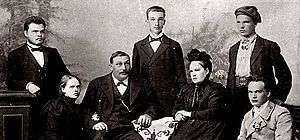
The Päts family originates from Holstre near Viljandi in the Governorate of Livonia. The family name "Päts" means a "loaf" in Estonian and is thought to derive from their ancestors from the beginning of the 18th century, who distributed free bread from their mill during a famine. The mill was initially named the Päts Mill and later "Päts" (originally "Paets") was adopted as an official surname.[3]
The father of Konstantin, Jakob (Jaagup) Päts (1842–1909), was a housebuilder from Heimtali, near Viljandi. Konstantin's mother, Olga Päts (née Tumanova; 1847–1914), was from a mixed Estonian-Russian family and as an orphan grew up with foster parents in the Razumovsky family, where the father, her uncle, was the mayor of Valga. It is also claimed that she grew up with the Krüdener family, where the father, Baron Krüdener, was his uncle; however it is more likely that she served the Krüdener family later as a governess. Jakob and Olga met while they were both in the service of the Krüdener family.[3]
Konstantin had an older brother Nikolai (1871–1940), three younger brothers Paul (1876–1881), Voldemar (1878–1958) and Peeter (1880–1942) and a younger sister Marianne (1888–1947). Since their mother Olga was raised in a wealthy Russian family, their father Jakob converted from Lutheranism to Eastern Orthodox Christianity. The children were all brought up in strong Orthodox traditions and were said to have a realistic mindset, just like their parents.[3]
The family initially lived in Viljandi. Jakob was among the peasant activists during the Estonian national awakening, who pleaded to Emperor Alexander II against the oppression by Baltic German nobility in 1865. After this, he came into conflict with the local nobility and was forced to move to Tahkuranna, near Pärnu, in 1873. As Konstantin's father was unable to find a job in Tahkuranna, the family moved to a rental apartment Pärnu in 1882. Three years later Jakob bought himself land in Raeküla near Pärnu, where they initially lived in the roadside Petlema Tavern, but built a new house after the tavern burned down. Jakob divided his land into smaller lots and built half a dozen new houses to the site that eventually grew into a borough and later a district of Pärnu.[3]
Early life
Konstantin Päts was born on 23 February [O.S. 11 February] 1874 near Tahkuranna. According to locals, he was born in a barn of a roadside farm, since his mother couldn't reach a doctor in time.[4] He was baptized in the Tahkuranna Orthodox Church.[5] Konstantin started his education in the Orthodox parish school of Tahkuranna.[4] In Pärnu, Konstantin attended the Russian language Orthodox parish school. Later he attended the Riga Clerical Seminar in 1887–1892, but after deciding not to become a priest, he left for the high school in Pärnu.[6]
From 1894 to 1898, he attended the Faculty of Law of Tartu University, that he graduated as cand. jur. After graduation, Päts served in the Russian 96th Infantry Regiment of Omsk in Pskov and was promoted an ensign.[6] After rejecting an academic career in Tartu, he moved to Tallinn in 1900, to start a political career.[7]
Career
Journalism
In Tallinn, Konstantin Päts started his career as an assistant at the advocacy of Jaan Poska, but the job wasn't satisfactory for Päts. In Tartu, Jaan Tõnisson had already founded his nationalist newspaper Postimees in 1891, Päts was planning to found his own in Tallinn. The first inspiration came from writers Eduard Vilde and Anton Hansen Tammsaare, who could not get a licence from the Ministry of Internal Affairs because of their social democratic views. Instead they used Päts as an unknown lawyer with an affiliation in the Orthodox Church.[8]
Päts was considered by the authorities to establish a newspaper that was loyal to the Empire and would "unite all Orthodox Estonians", however in reality his newspaper had a radical political content. The first issue of the Teataja ("The Gazette") came out on 23 October [O.S. 10 October] 1901, starting a rivalry not only between Postimees and Teataja, but also between Jaan Tõnisson and Konstantin Päts for the leading national figures. Instead of the ideological and nationalist Postimees, Teataja emphasized the importance of economic activity. The work was made difficult by strong government censorship.[8]
Early political career
Päts's first political goal was to take power in the towns, where Baltic Germans still controlled the municipal governments. Päts served as a municipal adviser in Tallinn from 1904[6] and together with Jaan Poska, he organized an electoral block between Estonians and liberal Russians, which managed to win at the 1904 Tallinn municipal elections. Päts became a member of the city council and in April 1905, he became the deputy mayor, chairing the city council.[4] His active work at the town government left him little time for his newspaper. A group of revolutionaries, led by Hans Pöögelmann, had taken control in Teataja's staff and published anti-government articles and called people for a revolution.[8]
During the 1905 Revolution, Päts was already an activist on self-government reform, where he supported national autonomy in the Baltic governorates.[9] In the escalation of the revolution, his newspaper was closed and its staff members arrested. Päts found out about this in advance and managed to escape to Switzerland, only to find out that he had been condemned to death in the Russian Empire.[4]

In 1906 he moved to Helsinki, Finland, where he continued his literary and journalist career. Much of his work was published anonymously in Estonia. He also advised local municipalities on land reform questions. In 1908, Päts moved to Ollila, which was located at the Russian border near Saint Petersburg. There he became one of the editors for the Estonian newspaper Peterburi Teataja ("The St Petersburg Gazette"), although he resided still in Finland. In Ollila, he was reunited with his family, with whom he had parted when he escaped to Switzerland in 1905.[4]
After his wife had gotten seriously ill, Päts found out that he was no longer condemned to death in the Russian Empire. He moved back to Estonia in 1909, to face only minor charges. From February 1910, he served time in Kresty Prison in Saint Petersburg, while his wife died of tuberculosis in Switzerland, where Päts had sent her for treatment. During his imprisonment, he was able to study foreign languages and write articles, to be published in newspapers.[4] Päts was released on 25 March 1911. The governor of the Governorate of Estonia complained about Päts's activity in Estonia in 1905 and pleaded for the government not to let him return[10] and he was banned from living in the Governorates of Estonia and Livonia for six years. However, strong connections with Jaan Poska helped him return to Estonia, where he founded another newspaper, Tallinna Teataja ("The Tallinn Gazette").[4]
From February 1916, Päts served as an officer in Tallinn and in July 1917, he was elected as Chairman of the Supreme Committee of Estonian Soldiers, where he actively worked to form Estonian units in the Imperial Army. During the war, he also organized the cooperation between Estonians and liberal Baltic German estate owners.[4]
Autonomy and German occupation
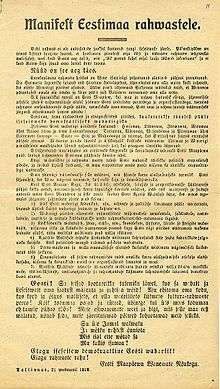
In 1917, when German forces were advancing on Estonia, Päts was able to avoid the mobilization. Since the control after the February Revolution was in the hands of the Russian Provisional Government, Estonians were pursuing for an autonomy within the Russian Empire. In local debates on whether to form one or two autonomous governorates in Estonia, Konstantin Päts, who supported a single autonomous governorate, took yet another victory from Jaan Tõnisson, who supported two autonomous governorates. After Estonian mass protests in Petrograd, the provisional government formed the autonomous Governorate of Estonia on 12 April [O.S. 30 March] 1917.[7]
The Estonian Provincial Assembly (Maapäev) was elected; Päts joined and became one of the leading figures of the Estonian Country People's Union, which took 13 of the 55 seats. Left- and right-wing politicians gained an equal number of seats in the Provincial Assembly, which made it difficult to appoint a speaker for the assembly. Jaan Tõnisson of the centre-right nominated the candidacy of Konstantin Päts, who however lost with only one vote to the almost unknown Artur Vallner. At first, Päts chose not to join any of the parliamentary groups, but eventually joined the most right-wing Democratic group.[11] Päts replaced Jaan Raamot as chairman of the provincial government on 25 October [O.S. 12 October] 1917.[12] During the October Revolution, Bolsheviks took control in Estonia and the Provincial Assembly was disbanded. After failing to give over official documents, Päts was arrested three times, until he finally went underground.[4]
Since Bolshevik power in Estonia was relatively weak, the Council of Elders of the Maapäev declared on 28 November [O.S. 15 November] 1917, that the assembly was the only legally elected and constituted authority in Estonia. Since even the Council of Elders was too big to work underground, the three-membered Estonian Salvation Committee was formed on 19 February 1918 and Konstantin Päts became one of its members.[7]
Soviet Russian forces evacuating, the Salvation Committee wanted to use the interregnum and declare Estonia's independence. On 21 February 1918, a delegation with Päts was sent to Haapsalu, that was chosen to be the site of the initial declaration, but they were forced to head back to Tallinn, since German forces had captured Haapsalu on the very same day. Attempts to reach Tartu before German occupation had also failed.[13]
When Soviet Russian forces had finally evacuated from Tallinn and German forces were advancing, the Salvation Committee issued the Estonian Declaration of Independence on 24 February 1918 (The declaration had also been delivered to Pärnu, where it was proclaimed on 23 February). Instantly the Estonian Provisional Government was formed and Konstantin Päts became the Chairman of the Council of Ministers, the Minister of Internal Affairs and the Minister of Commerce and Industry.[14] The position of Minister of Commerce and Industry probably remained vacant in reality.[15]
On 25 February 1918, German forces captured Tallinn and arrested Konstantin Päts on 16 June 1918. He was sent to several prison camps in Latvia until he was finally placed in a camp in Grodno, Poland.[16] He was released at the end of the war on 17 November 1918.[17]
After the Deputy Chairman of the Council of Ministers Jüri Vilms mysteriously died in Finland, Jaan Poska led the underground republic. After Germany surrendered, Konstantin Päts's 2nd cabinet of the provisional government took office on 12 November 1918, making Päts the Prime Minister of the provisional government and the Minister of Internal Affairs.[18]
After Päts arrived to Tallinn and the Maapäev had gathered, Päts's 3rd cabinet of the provisional government was formed on 27 November 1918, with Päts as Prime Minister of the provisional government and also the Minister of War, leaving it up to him to organize national defence. However, due to his multiple portfolios in the government, much of the work in the Ministry of War to higher officers.[19]
War of Independence
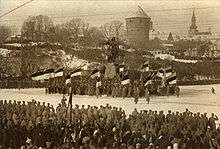

Päts founded the Estonian Defence League to provide defence for the advancing Red Army. On 28 November 1918, Soviet Russian forces captured Narva, which resulted the Estonian War of Independence. During a government meeting, Konstantin Päts banged his fist on the table and refused to compromise with the communists. This persuaded other government members to start a war against Soviet Russia. In January 1919, Estonians forced the Bolsheviks to retreat and by 24 February 1919, the entire Estonian territory was under the control of the provisional government. In his speech at the 1919 Independence Day parade, he said: "We have to secure our economy so we could become less dependent from our allies. In order to avoid bankruptcy, we have to found our state on agriculture". This became the basis for the Estonian economy for the next 20 years.[4]
In April 1919, the Estonian Constituent Assembly was elected, but the Estonian Country People's Union won only 8 of the 120 seats, leaving the majority to centre-left parties. On 9 May 1919, Otto August Strandman took over as the first Prime Minister. In the summer of 1919, Päts opposed going into war with the Baltic German Landeswehr, but as he was in opposition, the government decided to start the Landeswehr War, which ended in Estonian-Latvian victory. After the war had ended on 2 February 1920, the majority left-wing Constituent Assembly adopted the radical land reform law and the first constitution, which brought down a very proportional parliament, short government cabinets and no separate and stable head of state.[20]
Democratic republic
In September 1919, Päts formed a new political party, the agrarian-conservative Farmers' Assemblies, which was based on the Country People's Union.[21] In 1920 elections, the party won 21 seats in the 100-member Riigikogu and from 25 January 1921 to 21 November 1922, Konstantin Päts was the State Elder and led the first constitutional government cabinet. It was a centre-right coalition with three centrist parties. The cabinet fell soon after the centre-left Estonian Labour Party left the coalition because of Päts's right-wing policies and criticism of corruption within the Bank of Estonia. After stepping down as head of government, Päts served as President (speaker) of the Riigikogu from 20 November 1922 to 7 June 1923.[22]
In 1923 elections, Farmers' Assemblies took 23 seats. On 2 August 1923, Päts became State Elder for the second time. A similar centre-right coalition with three centrist parties lasted again until the Estonian Labour Party left the coalition, forcing Päts to step down on 26 March 1924. Otto August Strandman had openly criticized Päts for his role in corruption within the Bank of Estonia and economic policies that depended on trade with Russia. Päts kept away from office politics for seven years.[23] Support for his party didn't decline. From 15 December 1925 to 9 December 1927, Jaan Teemant of the Farmers' Assemblies was the State Elder.
In 1926 elections, Farmers' Assemblies took again 23 seats and Jaan Teemant continued as State Elder. Already in 1927, Päts criticized members of the Riigikogu, saying that they have been causing the instability of government coalitions, rather than ideological differences.[24] At the 6th Congress of Farmers' Assemblies in 1929, the party was in opposition to August Rei's leftist government and Päts, among others, demanded changes in the constitution, a smaller parliament, a separate presidential office and fight against corruption.[25]
In 1929 elections, Farmers' Assemblies took 24 seats and Päts served his third term as State Elder from 12 February 1931 to 19 February 1932. It was an ideologically wide coalition with the Estonian Socialist Workers' Party and the centre-right Estonian People's Party. On 26 January 1932, Farmers' Assemblies and the left wing-agrarian Settlers' Party merged to form the Union of Settlers and Smallholders, only to be followed by the formation of the National Centre Party by four centrist parties. Päts's cabinet resigned, making Jaan Teemant the new State Elder.[26]
In 1932 elections the newly formed Union of Settlers and Smallholders won 42 seats in Riigikogu and one of the party's leaders, Karl August Einbund, became the State Elder. On 3 October 1932, the coalition between the Union of Settlers and Smallholders and National Centre Party broke up, with the latter wanting to devalue the Estonian kroon during the Great Depression. Päts himself was one of the key opponents of devaluation.[27]
A month-long government crisis started. Since there were only three major parties in the Riigikogu, the third being the Estonian Socialist Workers' Party, no functioning coalition could be found until special authority was given to Konstantin Päts to form a grand coalition between all three major parties. His cabinet took office on 1 November 1932. On 25 November 1932, Päts's government was given more powers by the disunited Riigikogu to deal with the economic crisis. His government was forced to resign on 18 May 1933, after the National Centre Party, still favouring devaluation, left the coalition and the Union of Settlers and Smallholders had lost many of its members to the reactivated Settlers' party.[28] The succeeding Tõnisson's National Centre Party cabinet devalued the Estonian kroon by 35% on 27 June 1933. Although the devaluation proved to be successful and had a good impact to the economy later under his own rule, Päts never recognized his mistake by opposing the devaluation.[27]
Lack of government stability led to several new constitution proposals, but only the third proposal by the right-wing populist Vaps Movement was accepted in a referendum on 14 and 16 October 1933. Päts was elected on 21 October 1933 to head the non-aligned transitional government to the second constitution. Until 24 January 1934, he served as State Elder, but after the new constitution came into force, he became Prime Minister. The new constitution was a drift from democracy, giving a lot of power to the head of state (still named "State Elder") and leaving the Riigikogu only an advisory role.[29]
Both Päts and his recent predecessor Jaan Tõnisson tried to control the Vaps Movement that was seen by democratic parties as a local National Socialist party that had to be kept away from power.[30] In August 1933, State Elder Jaan Tõnisson had declared a state of emergency and temporary censorship,[31] that was lifted only when Päts's transitional government took office.[32]
The weak government response only gained support for the Vaps Movement and in early January 1934, the movement won municipal elections in several urban municipalities.[33] On 27 February 1934, Päts himself imposed a law, prohibiting members of the military to take part in politics. This action forced several thousand members of the army to secede from the Vaps Movement.[34]
Päts was one of the candidates in the presidential elections that were supposed to be held in April 1934, but the Vaps Movement candidate Andres Larka and even lieutenant general Johan Laidoner were both thought to be more popular candidates than Päts. The campaign was accompanied by threats by the Vaps Movement to take power and rumours of a forthcoming coup. In early March 1934, Päts's political opponent Jaan Tõnisson compared the Vaps Movement with the Nazis in Germany and advised the government to take necessary action against the movement.[33] Konstantin Päts then carried out a self-coup on 12 March 1934. He was supported by general Johan Laidoner and the army.[30]
Era of Silence
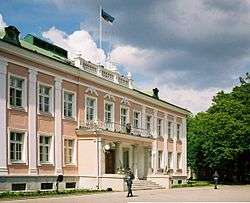
A state of emergency was declared and the Vaps Movement was disbanded, with about 400 members arrested, including the presidential candidate Andres Larka. Johan Laidoner was appointed Commander in Chief of the Armies.[35]
Speaking in the Riigikogu on 15 March, Päts stated that the Estonian people are "blinded by the propaganda of the Vaps Movement and ill-minded because of it, and the power could therefore not be in the hands of the people".[36] On 15–16 March 1934, the Riigikogu approved of Päts's actions in hopes of saving Estonian democracy. Päts postponed the presidential elections for the duration of the emergency, expressing concern about "emotions being too high because of anti-government agitation by the Vaps Movement".[35]
In August 1934, Päts appointed Karl August Einbund as Minister of Internal Affairs, making him the third leading figure of the era next to Päts and Laidoner. In September, the Agitation and Propaganda Department was created,[37] in October, all parliamentary work was stopped after the opposition criticized the political restrictions[38] and in December, censorship was introduced.[39]
In February 1935 the Patriotic League (Isamaaliit) was formed to replace political parties,[40] while all other political organizations were disbanded in March. Päts thought that political organizations should unite the society, not fragment it.[41] The initial state of emergency was declared for six months in March 1934, but after September 1934, Päts extended it for a year in a total of six times.[42][43][44][45][46][47]
As Päts believed that a nation should be organized not by political views into parties, but by vocation into respective chambers, a series of state corporative institutions were introduced, based on corporatism in Fascist Italy. Päts had promoted the idea of corporate chambers already in 1918, but the idea did not gain support from strong left-wing parties at the time. Päts was the main proponent of the formation of the chambers and the first two were founded while his government cabinets were in office in 1924 and 1931. Fifteen more chambers were established between 1934 and 1936, bringing the total number to 17.[48]
On 7 December 1935, a coup d'état attempt (the "Estonia plot", named after the Estonia Theatre) by the Vaps Movement was exposed. More than 750 people were arrested throughout the state, crushing the movement conclusively.[49] Leaders of the movement were eventually given punishments as hard as 20 years of forced labour,[50] they were pardoned in December 1937.[51]
Meanwhile, Jaan Tõnisson had criticized Päts's inability to bring the new constitution into effect. In July 1935, Tõnisson was ousted from the Postimees board.[52] In October 1936, four former State Elders, Juhan Kukk, Ants Piip, Jaan Teemant and Jaan Tõnisson, sent a joint letter to Päts, demanding civil freedoms and restoration of democratic regime.[53] Reluctance to restore democracy also caused student riots in Tartu in the autumn of 1936, which led to clashes with the police and disbandment of the student council of the University of Tartu.[54]
The lack of organized opposition during the emergency made it easier for Päts to pass reforms. Päts ruled mostly through presidential decrees, because the Riigikogu was needed to pass real laws. The economy grew and the infrastructure, industry, and education were developed. The Estonianization of personal names was supported, the most prominent example being Minister of Internal Affairs Karl August Einbund, who changed his name to Kaarel Eenpalu.[55]
Päts also signed a decree to bring the Supreme Court from Tartu to Tallinn in 1935, although all but one of the justices voted against it. After the coup, the Supreme Court lost many of its powers and was not able to observe the implementation of democratic principles in the country.[56] Päts also founded the Tallinn Technical Institute on 15 September 1936 as the second university in Estonia. Losing the Supreme Court and some faculties in the university definitely reduced the importance of Tartu in Southern Estonia - the town that had historically been supportive to Päts's opponent Jaan Tõnisson.[57]
Regarding the 1934 constitution as too authoritarian, Päts organised the passing of a new constitution through a referendum and a constituent assembly. The corporate chambers were to be the basis of forming the assembly.[58] Its formation was approved (with 76% in favour) in a referendum in 1936. The 1936 National Assembly elections were boycotted by the opposition in most electoral districts.[59]

On 28 July 1937, the assembly adopted the third constitution, that was based on Päts's draft.[60] A bicameral parliament was to be elected and the president was to be elected by the parliament, not by the people. On 3 September 1937, a 120-day period of transition began, during which Päts ruled as President-Regent.[45]
On 1 January 1938, the new constitution came into force and the 1938 parliamentary elections were held. Opposition candidates were allowed to take part, however they were given little or no attention in the media. Päts's supporters in the National Front for the Implementation of the Constitution won 64 of the 80 seats in the lower chamber, the Riigivolikogu. The president, who was yet to be elected, was also able to directly appoint into office 10 of the 40 members of the higher chamber, Riiginõukogu.[61]
On 23 April 1938, Konstantin Päts was nominated a presidential candidate by both chambers of the Riigikogu and also the Assembly of Municipal Representatives. Jaan Tõnisson was the only opposition candidate in the lower chamber Riigivolikogu. Of its 80 members, 65 voted for Päts and 14 for Tõnisson. There were no opposition candidates in the upper chamber Riiginõukogu and in the Assembly of Municipal Representatives. In there, Päts received 36 from a total of 40 and 113 from a total of 120 votes, respectively.[62]
In accordance with the Constitution, since both the two chambers of the Riigikogu and the Assembly of Municipal Representatives had nominated the same candidate, the presidential elections were canceled. The collective electoral body convened on 24 April 1938 and voted with 219 in favor of the candidate and 19 ballots were left empty. From a total of 240 votes, the 219 were more than the necessary 3/5 majority or 144 votes.[62]
In the same evening, Päts gave the presidential oath of office in front of the Riigikogu and thus became the first President of Estonia. Päts stated: "And if today we have reached a time and place, where we have built up and organized our national institution, then this is the happiest day in my life." He was then awarded with the special sash of the Order of the National Coat of Arms as the presidential decoration and several other decorations by the Deputy Prime Minister Kaarel Eenpalu.[63]
On 9 May 1938, Päts appointed Kaarel Eenpalu as Prime Minister. On 5 May 1938, all political prisoners, mostly communists and members of the Vaps Movement, were given amnesty. There is no consensus, whether the so-called "Era of Silence" ended in 1938 with the adoption of the new constitution, or in 1940 with the Soviet occupation. The era of 1934–1940 is generally also called the "Päts Era".[64] Also in 1938 a general amnesty was granted for those political prisoners of the Vaps movement and the Communist Party, who had not directly killed anyone.
Late republic and Soviet occupation


After the beginning of World War II Estonia declared its neutrality, but was compelled to sign the Soviet–Estonian Mutual Assistance Treaty on 28 September 1939 to allow Soviet military bases and 25,000 troops in Estonia. On 12 October 1939, Päts appointed Jüri Uluots as a new, moderate Prime Minister.[65]
In May 1940, Päts believed that the best option for Estonia would be to follow Soviet guidelines until the German-Soviet war. In case of such war, "Estonia would be saved".[66] However, on 16 June 1940, the Soviet Union delivered an ultimatum to the Estonian government. Päts's first reaction was to consult with the businessman Joakim Puhk. The Estonian government was forced to accept the ultimatum and a full Soviet invasion followed on 17 June 1940.[67]
Päts was allowed to stay in office, but on 21 June was forced to appoint the Soviet puppet Johannes Vares as prime minister. Now effectively a puppet himself, for an entire month Päts signed about 200 decrees for the new Soviet regime.[68] Among other things, he signed a decree to change the electoral law, allowing the new regime to organize preliminary elections. This law was illegal, since the upper house of the Riigikogu had been dissolved and never reconvened. The new elections were only for the lower chamber, the Riigivolikogu, with voters being presented with a single list of Communists and fellow travellers. On Victory Day of 23 June 1940, Päts declared: "the greatest thing we have accomplished is the creation of the Estonian state. To her we have given our strongest love, our loyalty, our work, and our life." From 29 June 1940, Päts remained under permanent house arrest.[69] Even in early July, Päts declared to the German ambassador that he did not believe Estonia would be Sovietized.[70] On 21 July 1940, the Estonian SSR was proclaimed and it is claimed that only then Päts realized the essence of the Soviet occupation.[71]
Deportation and imprisonment
On the same day, Päts sent his son Viktor to visit the United States Legation in Tallinn and appeal for protection and asylum in the United States for himself and his family.[72] The Acting Secretary of State Sumner Welles did allow the entire Päts family to be granted diplomatic visas already on the next day.[73] Many Soviet-era and even sources claim that Päts resigned on 21 July 1940. Other sources however claim that he resigned on 22 July and the resignation was approved on 23 July, making Päts the president of the Estonian Soviet Socialist Republic for two days.[71] Whatever the case, Vares took over the president's powers as "Prime Minister in duties of the President," thus giving legal sanction to the final stages of Estonia's annexation by the Soviet Union.
Either the American visas came too late or the Päts family remained under house arrest, but on 30 July 1940, together with his son Viktor and Viktor's wife Helgi-Alice and sons Matti and Henn, Konstantin Päts was deported to Ufa, Bashkir ASSR, where they arrived on 9 August. There they lived under surveillance in a large apartment for a year. In Ufa, Päts wrote his memoirs of his time in office and pleaded that his grandsons, their mother, and nanny would be sent to either Switzerland or Italy, since his grandson Henn was already in a bad health. After receiving no answer, he pleaded for them to be sent back to Estonia. In his naivety, he pleaded to be exchanged with Ernst Thälmann, former leader of the Communist Party of Germany, who was imprisoned in Germany. After that, Päts remained quiet, while his son Viktor was certain that Nazi Germany would invade the Soviet Union and that he would soon be living abroad.[74]
The family "randomly" met an Estonian couple, both NKVD agents, in an Ufa market on 29 May 1941. They received an invitation to the family's home the next day. After the visit, it was reported that both Konstantin and Viktor demonstrated particular viciousness against Joseph Stalin and Vyacheslav Molotov, sympathized with Germany and announced, that they were impatiently waiting for a German assault on the Soviet Union.[74]
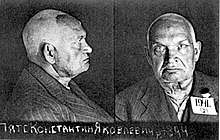
On 26 June 1941, they were arrested and imprisoned in Ufa, the children were sent to an orphanage. Päts was interrogated for hours, but did not take the blame. Even in March, 1942, he believed that the Western powers would pressure the Soviet Union to send him abroad. Eventually, Päts and his son were sent to Butyrka prison in Moscow and Helgi-Alice to Gulag prison camps in Siberia. In Butyrka prison, Johan Laidoner was prisoner No. 11, Konstantin Päts No. 12 and Viktor No. 13.[75][76]
On 24 March 1943, Päts was sent to forced treatment in psychoneurotic hospitals first in Kazan, then in Chistopol in Tatar ASSR. His forced psychiatric hospitalization was justified by his "persistent claiming of being the President of Estonia". On 29 April 1952, Päts was found guilty according to § 58-14 and § 58-10 of the Penal Code, which meant counter-revolutionary sabotage and anti-Soviet and counter-revolutionary propaganda and agitation. Forced treatment was ended in 1954 and Päts was sent to a psychoneurology hospital in Jämejala, Estonia. Recognition by the locals and too much attention resulted him being sent to Burashevo psychiatric hospital in Kalinin Oblast (now Tver Oblast), where he eventually died on 18 January 1956.[77]
Economic and cultural activities
Päts actively participated in economic activities. In periods between 1919 and 1933, he was chairman of the insurance company "Estonian Lloyd". From 1925 to 1929, Päts was chairman of the council of the Chamber of Commerce and Industry and continued as its honorary councillor from 1935. He also served as the chairman of the board of the Harju Bank and chairman of the Tallinn Exchange Committee.[6]
Päts was among the founders of Estonian Sports Association Kalev in 1901 and also its first deputy chairman.[78] Päts was the chairman of Estonian-Finnish-Hungarian Association from 1925 to 1936 and continued as honorary chairman from 1936. From 1927 to 1937, he was the chairman of the "Fenno-Ugria" foundation.[6]
Päts received honorary doctorates from Tartu University in 1928, Tallinn Technical University and Andhra University (in India) in 1938, along with honorary membership of the Learned Estonian Society in 1938 and the Estonian Academy of Sciences in 1939. In 1938, he became honorary member of the Estonian Naturalists' Society (Loodusuurijate Selts) and the Estonian Institute of Natural Resources (Loodusvarade Instituut). He was also named honorary alumnus of the fraternal student corps Fraternitas Estica and honorary citizen of Tallinn, Narva, Pärnu and Tartu and Tahkuranna Parish.[6]
Foreign relations
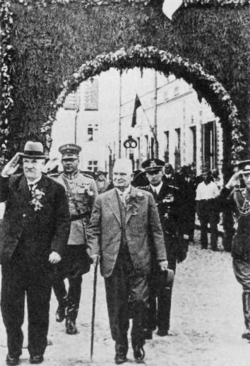
In 1918, Päts made a proposal for an Estonian-Finnish personal union. However, Finnish leaders weren't so eager about the union and the idea was rejected.[79] Päts still bore the idea in his mind, as testified by his so-called "political testament", written in July 1940. In 1922, during his first term as State Elder, he made the first Estonian state visit, to Finland. He also made unofficial visits to Finland in 1931,[80] 1935[43] and 1937. President of Finland, Pehr Evind Svinhufvud visited Estonia twice during Päts's authoritarian rule, in 1934[81] and in 1936.[82]
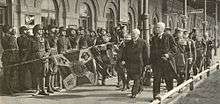
In 1933, Päts also made a state visit to Latvia[83] and the Baltic Entente between Estonia, Latvia and Lithuania was signed in 1934 during his authoritarian regime. This agreement was another attempt to draw Finland closer to Estonia, but saw no results. During the 1930s, Estonian and Polish officials made several state visits to both countries.[42]
In late 1930s, the Soviet Union excited interest for the Baltic states, causing Estonia to move closer to Germany in its foreign policy. This change was marked by appointing the ambassador to Germany, Friedrich Karl Akel, as Minister of Foreign Affairs in 1936.[84] On 3 December 1938, Estonia declared its neutrality.[85]
Criticism
Economic activities
Several aspects of Päts's career are still under critical public debate and various theories have been created, although many of them have also seen broad criticism.[86]
In 1920–1922 Estonia had stronger relations with Soviet Russia than other European countries. The Russian embassy in Tallinn was at the center of Russian gold sale to the West, which constituted about 4% of global gold sales in that period. Estonia and the Bank of Estonia received about 2/3 of the at least 30 million gold rubles transaction fees. The transactions were kept in secret and mostly only the Director of the Bank of Estonia in 1920–1921 and Minister of Finance in 1921–1922, Georg Westel, and the State Elder in 1921–1922, Konstantin Päts, knew of these transactions.[87]
Even more, it was the Harju Bank that belonged among others to Päts and Westel that transacted many of the gold sales. Päts, Westel and other big businessmen, mostly members of Päts's Farmers' Unions party, have thus been accused to use this transaction money for their own good.[87] It has also been claimed that the Bank of Estonia gave out several loans to enterprises that were related to Päts's activities and almost all other loans were given to enterprises related to the members of the bank's own council and other top-level politicians. Having big loans was also the reason why Päts, Westel and other top-level politicians did not fight with the hyperinflation at the time.[87]
The gold exchange and big loans also boosted money circulation in Estonia, which created an illusion for the wider public that the economy of Estonia and the Estonian mark were in a good situation. It was only in December 1923 when former Prime Minister Otto Strandman of the Estonian Labour Party criticized the Minister of Finance Georg Vestel in the Riigikogu for incorrect spending of state treasury. Westel was divest of office and Strandman's criticism led to the eventual resignation Päts's 2nd cabinet in 1924 and led Päts to distance himself from public politics for seven years. Otto Strandman became Minister of Finance in 1924. He implemented his New Economic Policy (uus majanduspoliitika) of economic redevelopment, which stabilized the Estonian mark and detached the Estonian economy from dependence of trade with Russia.[23] Dependence on Russia and hyperinflation could have affected the social situation in Estonia crucially, especially in the light of 1 December 1924 communist coup d'état attempt.[87]
Coup d'état and authoritarian rule
While Päts has been seen by some as a politician who destroyed democracy in interwar Estonia, many Estonians today understand the threat the Vaps Movement could have caused to democracy and internal and external security. Furthermore, the coup was initially recommended by Päts's political opponent Jaan Tõnisson himself and the coup was supported by the democratically elected Riigikogu as well[33] as well as the moderate wing of the Estonian Socialist Party.
According to some historians however, Päts and his close allies used the 1934 coup for their own personal gains and not to keep the Vaps Movement from taking power. Several members of the Päts family gained important positions in ranging from clerical to cultural fields. Others have criticized the long time it took to adopt a new constitution, which was more than three years. [88]
Although Päts was generally considered to be a modest man, he himself or others did create some elements of cult of personality around him and he was often seen as the Father of the Nation. During his own rule, he was awarded with several state decorations. He was nominated honorary citizen of larger Estonian towns and some parishes. During the years of his presidency, the official state celebrations of the Estonian Independence Day began the day before, on Päts's birthday.[89] Päts was also the first and only person in interwar Estonia, who had postage stamps with his picture made and circulated, starting from 1936.[90]
His presidency was also characterized by somewhat authoritarian rule. In 1938, he founded a labor camp in Harku, where a total of 142 homeless people from Tallinn were interned in 1938–1939.[91]
Soviet occupation
His actions before and during the Soviet occupation have been questioned even more. In 1918, Päts refused to compromise with the communists, but in 1940, he gave Estonia to Soviets without many objections. This controversy has led to theories, that Päts was either a Soviet agent, a collaborator, took the Soviet invasion as inevitable or was just ill-minded and failed to deal with the situation.[86]
One of the more prominent critics has been Magnus Ilmjärv. He has suggested that the Soviet Union sought since the 1920s to literally buy off some of the top-level Estonian politicians. He suggests that the Soviets saw Päts and his conservative Farmers' Assemblies party to be the most suitable. The easiest way to influence Päts and his party is said to have been the Estonian-Russian Chamber of Commerce. Päts was secretly very Russian-minded, as he was grown in a Russian-language family. Ilmjärv even claims that Päts had suggested federation between Estonia and the Soviet Union to the Soviet embassy in Tallinn.[92]
Ilmjärv claims that Päts was against any "Baltic Union" that was propagated by Estonian Minister of Foreign Affairs Kaarel Robert Pusta. Päts is even documented to have said to the Soviet ambassador that he is against politicians like Pusta and he desires to create a new constitution that would reduce the power of the Riigikogu. Through Päts, the Soviet Union is said to have gotten Pusta out of government cabinet and with him, also end the ideas of a united Baltic state.[92]
It is also claimed that Päts purposefully gave up valuable information to the Soviets, when he negotiated the Estonian-Russian commerce treaty for Estonia. Päts also supported giving concession rights of the Narva River hydroelectric power plant to the German enterprise Siemens-Schuckert Werke that already had many projects in Russia and was influenced by it.[92]
An Estonian oil syndicate became a joint Estonian-Soviet enterprise in 1928 and Päts was hired by it as a legal consultant in 1930. His annual salary was $4,000, which was twice as much as the State Elder earned and more than eight times as muchs as Päts earned as a member of the Riigikogu. The purpose of the joint enterprise for the Soviets was not supposed to be business-related, but only to attract Päts. This official salary by the Soviet Union has thus been seen as the salary for his long-term cooperation with the Soviets. After Päts's coup d'état, the Soviet Union increased economic cooperation with Estonian enterprises.[92]
Other theories maintain that Päts trusted the Soviet officials and had befriended some of the Soviet leaders. It is also possible, that the NKVD controlled Päts's health or the information that reached him.[93] Finnish historian Martti Turtola claims that Päts's actions were in accordance with the Soviet Union's demands already since the signing of the Soviet–Estonian Mutual Assistance Treaty on 28 September 1939 and he didn't even once try to find more suitable compromises.[94]
It is also suggested that Päts's bad health and loneliness did not let him realistically analyze the situation.[93] Furthermore, it is suggested that Päts and his cabinet lacked the necessary knowledge in international affairs and the Molotov–Ribbentrop Pact of non-aggression between the Soviet Union and Nazi Germany may have come as a shock to the Päts cabinet.[94]
Another theory suggests, that Päts knew of the outbreaking war between Nazi Germany and the Soviet Union and was only looking for a way for Estonia to survive the short period in between.[93] It is suggested that Päts knew of the difficulty of the situation and tried to keep Estonians as safe as possible by avoiding war with the Soviets and buying time. While trying not to give the Soviet Union a chance to punish the Estonians, he also continuously postponed the mobilization, which eventually never even took place, unlike in Latvia and Lithuania in 1939–1940. Under international law a war would have invalidated the Tartu Peace Treaty.[94] As a lawyer, he also had to understand that his decisions were not valid when forced by an occupying power.[93]
Legacy
Politics
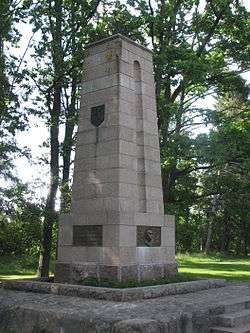
Konstantin Päts was relatively successful in internal politics. After adopting the constitution, his party was in all the government cabinets, except for Friedrich Karl Akel's and August Rei's cabinets and Jaan Tõnisson's fourth cabinet. This makes it 4,017 days (89%) in the government (of 4,497 in 1921–1933). Päts was himself the State Elder four times, a total of 1,476 days (33%). He never filled any other position in the government besides the head of government (except for the additional minister portfolios in the provisional government).
Päts served as the chairman of the Farmers' Assemblies party only unofficially and he was considered to be a bad partisan and often formed the opposition within the party. Therefore, he seldom took part of their official meetings. Only in 1933, he was made honorary chairman of the party.[95]
Membership in the parliament:
- 1917–1919 Estonian Provincial Assembly (Maapäev)
- 1919–1920 Estonian Constituent Assembly
- 1920–1923 I Riigikogu
- 1923–1926 II Riigikogu
- 1926–1929 III Riigikogu
- 1929–1932 IV Riigikogu
- 1932–1934/1937 V Riigikogu
Päts's ideology went through major changes during his career. During the 1905 Revolution, he was considered a socialist, as he advocated progressive ideas that were considered socialist at the time. During his exile years, he became more of a social liberal, trying to use the best of both ideologies. By the time Estonia became independent, he had become a conservative, and showed influences of statism during his authoritarian years.[96]
According to international law and the Estonian constitution, Päts's actions were of no effect from the beginning of the occupation, or at least from 21 June 1940, when Andrei Zhdanov forced him to appoint a puppet cabinet led by Johannes Vares. Estonia's official position since the end of the Soviet era has been that the laws passed by the Vares cabinet and promulgated by Päts were void in any case as they had not ratified by the upper chamber (Riiginõukogu) as required by the Estonian constitution.[97] The upper chamber was dissolved soon after the occupation and was never reconvened.
Legally, Päts remained the de jure President until his death in 1956. His active duties went to the last pre-occupation Prime Minister Jüri Uluots, who let Otto Tief form a government in 1944, before the Soviet reoccupation. After Uluots died in Stockholm in 1945, presidential duties went to the oldest member of Tief's cabinet, August Rei, who formed the Estonian Government in Exile in 1953. The last Prime Minister in duties of the President, Heinrich Mark, handed over his credentials to the incoming President Lennart Georg Meri on 8 October 1992.[98]
Society
A number of places and institutions in Estonia have been named after Konstantin Päts. Kentmanni street in Tallinn was named after Konstantin Päts in 1939–1940 and 1941–1944[99] and Lossi street in Põltsamaa was named after him in 1936–1940.[100] Konstantin Päts Boarding School of Tallinn was opened after Päts's own initiative for children with respiratory disorders.[101] During Päts's presidency, he had the creamy "Staatspräsident Päts" rose cultivar named after him and the flowers are being grown in the Kadriorg Park in Tallinn, near the presidential palace.[102]
A museum of Konstantin Päts was set up in 1991 in the Tallinn Botanical Gardens, where Päts's farmstead remains. The museum still exists, but the farmstead was returned to Päts's descendants in 1995.[103]
Päts has been portrayed in literature, one of the best known is the satirical Memoirs of Ivan Orav by Andrus Kivirähk, where Päts is portrayed as a true people's person, who was beloved by the entire nation and who was a thoroughly good person. In the puppet political satire show Pehmed ja karvased Päts is portrayed as a talking bust sculpture that is placed in the cellar of a governmental building together with other former presidents.[104] Periods of Päts's life as a side character were also portrayed in the television series Tuulepealne maa.[105]
Remains
In 1988, Estonians Henn Latt and Valdur Timusk decided to search for Konstantin Päts's remains in Russia. They reached Burashevo village, 15 km from Kalinin (now Tver), where Päts had been a patient in the hospital. They met his last doctor Ksenya Gusseva, who described Päts's funeral in 1956. She said that Päts was buried like a president – in a coffin, unlike other deceased patients of the time. On 22 June 1990, his grave was dug up and the remains were reburied in Tallinn Metsakalmistu cemetery on 21 October 1990.[106][107] In 2011, a commemorative cross was placed in Burashevo village, where Päts was once buried.[108]
Personal life

In 1901, Konstantin Päts married Wilhelma ("Helma") Ida Emilie Peedi (b. 1878),[109] whom he had met in Pärnu High School. They had two sons, Leo and Viktor. Konstantin left his family for exile in 1905 and his second son was born while he still resided in Switzerland. They were united when Konstantin moved to Ollila, Finland. His wife died of lung disease in 1910 while he was imprisoned in Saint Petersburg, and Päts never remarried. His children were raised by his wife's unmarried sister Johana (Johanna) Wilhelmine Alexsandra Peedi.[4] Konstantin Päts also had at least one godson.[110]
Päts was seen as a kind person, who was able to give good speeches, was grown in a rural area and therefore had a heart for the land. He took a special interest in issues related to children. He often donated money to large families and schools and organized events for students, which he also took part of. He was also known to take long walks in the morning in the Kadriorg park around the Presidential Palace and to get into conversations with park workers.[4] Konstantin Päts had diabetes.[89]
In 1919, Päts rented, organized and later bought a farmstead on the land detached from Väo Manor, just outside Tallinn.[111] He was later awarded a farmstead, like many other participants of and contributors to the Estonian War of Independence. His farmstead however was in Kloostrimetsa, in prime location just outside Tallinn.[112] Currently located within the Tallinn Botanic Garden, the farmstead has been returned to Päts's descendants.[75]
Descendants
Konstantin's eldest son, Leo Päts (1902–1988), managed to escape to Finland in 1939. He eventually moved on to Sweden, where he died in 1988.[113] Konstantin's second son, Viktor Päts (1906–1952), died in Butyrka prison in Moscow on 4 March 1952.[75] Viktor's sons Henn (Enn; 1936–1944) and Matti (b. 1933) were sent to an orphanage in 1941, but were soon separated. They were united once a week, until Henn died of starvation in Matti's arms in 1944.[74]
All living descendants of Konstantin Päts are the children and grandchildren of Matti Päts, who returned from Russia with his mother Helgi-Alice in 1946.[114] Helgi-Alice however was arrested again in 1950 and sentenced to 10 years in prison in Kazakh SSR and returned in 1955.[77] Matti Päts has been director of the Estonian Patent Office since 1991; he has also been a member of the Riigikogu and Tallinn city council. He was even seen as a potential candidate for the 2001 Presidential election by the conservative wing of the Pro Patria Union.[115]
Awards
1920 – Cross of Liberty I/I
1920 – Cross of Liberty III/I
1921 – Order of the Estonian Red Cross III
1926 – Order of the Estonian Red Cross I/I
1929 – Order of the Cross of the Eagle I
1938 – Special sash of the Order of the National Coat of Arms
1938 – Collar of the Order of the White Star
1938 – Collar of the Order of the National Coat of Arms
Bibliography
- Päts, Konstantin; Karjahärm, Toomas (1999). Eesti riik I. Eesti mõttelugu. Tartu: Ilmamaa. ISBN 9985-878-26-4.CS1 maint: ref=harv (link)
- Päts, Konstantin; Karjahärm, Toomas (2001). Eesti riik II. Eesti mõttelugu. Tartu: Ilmamaa. ISBN 9985-77-009-9.CS1 maint: ref=harv (link)
See also
- Estonian War of Independence
- Occupation of Baltic states
- Kaarel Eenpalu
- Johan Laidoner
- Jaan Teemant
- Antanas Smetona
- Kārlis Ulmanis
Notes
- Johannes Vares was the Prime Minister under Soviet occupation and is therefore not recognized as a legal Prime Minister of Estonia by the current Government of Estonia.
References
- Lees, Elle (2006). "Eesti Riigivanemad". MTÜ Konstantin Pätsi Muuseum. p. 3. Archived from the original on 24 December 2013. Retrieved 8 June 2013.
- "Riigikogu juhatus". Riigikogu.
- Pimeduse katte all leidis teenekas mees viimase puhkepaiga abikaasa kõrval Pärnu Postimees, 4 March 2005.
- Kallas, Vaino. "Eesti esimene president Konstantin Päts" Archived 15 May 2011 at the Wayback Machine.
- Tahkuranna Jumalaema Uinumise apostliku-õigeusu kirik. Puhkaeestis.ee.
- Konstantin Päts. President.ee.
- Eesti ajalugu elulugudes: 101 tähtsat eestlast. Olion. Tallinn, 1997. pp. 112–113.
- XX sajandi kroonika, I osa. Eesti Entsüklopeediakirjastus. Tallinn, 2002. P. 27.
- XX sajandi kroonika, I osa. Eesti Entsüklopeediakirjastus. Tallinn, 2002. P. 54.
- XX sajandi kroonika, I osa. Eesti Entsüklopeediakirjastus. Tallinn, 2002. P. 95.
- 1917 Archived 17 October 2013 at the Wayback Machine. Meie parlament ja aeg.
- XX sajandi kroonika, I osa. Eesti Entsüklopeediakirjastus. Tallinn, 2002. P. 158.
- Arjakas, Küllo. "23. ja 24. veebruar 1918: kuidas iseseisvust kuulutati" Archived 1 July 2011 at the Wayback Machine. Postimees, 23 February 2008.
- XX sajandi kroonika, I osa. Eesti Entsüklopeediakirjastus. Tallinn, 2002. P. 168.
- Valitsus 24.02.1918 - 12.11.1918. Government of Estonia.
- XX sajandi kroonika, I osa. Eesti Entsüklopeediakirjastus. Tallinn, 2002. P. 175.
- Arjakas, Küllo. "Konstantin Pätsi vanglaelu". Eesti Päevaleht, 18 September 1999.
- Valitsus 12.11.1918 - 27.11.1918. Government of Estonia.
- Parming, Tõnu. "3. jaanuari hommikul 1920 lõppes ...". Postimees, 18 January 1996.
- "Konstantin Päts Eesti peaministrina.". Histrodamus.ee, retrieved 14 December 2015.
- Nohlen, D. & Stöver, P. (2010). "Elections in Europe: A data handbook", ISBN 978-3-8329-5609-7. P. 579.
- XX sajandi kroonika, I osa. Eesti Entsüklopeediakirjastus. Tallinn, 2002. P. 246.
- Kukk, Kalev. "Otto Strandman manitseb tänaseid eelarvetegijaid". Sirp, 12 September 2008.
- XX sajandi kroonika, I osa. Eesti Entsüklopeediakirjastus. Tallinn, 2002. P. 298.
- XX sajandi kroonika, I osa. Eesti Entsüklopeediakirjastus. Tallinn, 2002. P. 319.
- XX sajandi kroonika, I osa. Eesti Entsüklopeediakirjastus. Tallinn, 2002. P. 354.
- Pruuli, Jaanus. "Eesti krooni devalveerimise vaevaline teekond, Kui kukkus maailma majandustala, inglise naelsterling". Postimees, 26 June 1997.
- XX sajandi kroonika, I osa. Eesti Entsüklopeediakirjastus. Tallinn, 2002. P. 364.
- XX sajandi kroonika, I osa. Eesti Entsüklopeediakirjastus. Tallinn, 2002. P. 380.
- XX sajandi kroonika, I osa. Eesti Entsüklopeediakirjastus. Tallinn, 2002. P. 383.
- XX sajandi kroonika, I osa. Eesti Entsüklopeediakirjastus. Tallinn, 2002. P. 375.
- XX sajandi kroonika, I osa. Eesti Entsüklopeediakirjastus. Tallinn, 2002. P. 377.
- "Vapsid alahindasid Pätsi meelekindlust". Postimees, 12 March 2004.
- XX sajandi kroonika, I osa. Eesti Entsüklopeediakirjastus. Tallinn, 2002. P. 381.
- XX sajandi kroonika, I osa. Eesti Entsüklopeediakirjastus. Tallinn, 2002. P. 283.
- "Pätsi ja Laidoneri riigipööre, Vaikiva Ajastu algus". Histrodamus.ee, retrieved 1 December 2014.
- XX sajandi kroonika, I osa. Eesti Entsüklopeediakirjastus. Tallinn, 2002. P. 391.
- XX sajandi kroonika, I osa. Eesti Entsüklopeediakirjastus. Tallinn, 2002. P. 392.
- XX sajandi kroonika, I osa. Eesti Entsüklopeediakirjastus. Tallinn, 2002. P. 394.
- XX sajandi kroonika, I osa. Eesti Entsüklopeediakirjastus. Tallinn, 2002. P. 399.
- XX sajandi kroonika, I osa. Eesti Entsüklopeediakirjastus. Tallinn, 2002. P. 401.
- XX sajandi kroonika, I osa. Eesti Entsüklopeediakirjastus. Tallinn, 2002. P. 390.
- XX sajandi kroonika, I osa. Eesti Entsüklopeediakirjastus. Tallinn, 2002. P. 406.
- XX sajandi kroonika, I osa. Eesti Entsüklopeediakirjastus. Tallinn, 2002. P. 420.
- XX sajandi kroonika, I osa. Eesti Entsüklopeediakirjastus. Tallinn, 2002. P. 434
- XX sajandi kroonika, I osa. Eesti Entsüklopeediakirjastus. Tallinn, 2002. P. 449.
- XX sajandi kroonika, I osa. Eesti Entsüklopeediakirjastus. Tallinn, 2002. P. 465.
- Karjahärm, Toomas (2002). ""Konstantin Pätsi poliitilised ideed"". In Arjakas, Küllo; Velliste, Anne (eds.). Konstantin Pätsi tegevusest : artiklite kogumik. Tallinn: Museum of Konstantin Päts. ISBN 9985-78-341-7. Archived from the original on 13 January 2014. Retrieved 7 June 2011.
- XX sajandi kroonika, I osa. Eesti Entsüklopeediakirjastus. Tallinn, 2002. P. 410.
- XX sajandi kroonika, I osa. Eesti Entsüklopeediakirjastus. Tallinn, 2002. P. 416.
- XX sajandi kroonika, I osa. Eesti Entsüklopeediakirjastus. Tallinn, 2002. P. 437.
- XX sajandi kroonika, I osa. Eesti Entsüklopeediakirjastus. Tallinn, 2002. P. 405.
- XX sajandi kroonika, I osa. Eesti Entsüklopeediakirjastus. Tallinn, 2002. P. 421.
- Alatalu, Toomas. "Mis seal salata, olen rahul, et ..." Postimees, 29 October 1996.
- "V Riigikogu 15.06.1932 – 02.10.1934.". Meie parlament ja aeg, retrieved 14 December 2015.
- "Päts viis Riigikohtu vägisi ära Tallinna". Postimees, 14 January 2005.
- Tamm, Boris. "Noored, raputage endilt hirm tehnika ees!" Postimees, 14 June 2001.
- Payne, Stanley George (1995). A History of Fascism, 1914–1945. ISBN 1-85728-595-6
- XX sajandi kroonika, I osa. Eesti Entsüklopeediakirjastus. Tallinn, 2002. P. 423.
- XX sajandi kroonika, I osa. Eesti Entsüklopeediakirjastus. Tallinn, 2002. P. 432.
- XX sajandi kroonika, I osa. Eesti Entsüklopeediakirjastus. Tallinn, 2002. P. 440..
- "Presidendi valimine läbi Eesti ajaloo". Postimees, 22 September 2001.
- Lõhmus, Alo. "Päts sai presidendiks paari päevaga". Postimees, 9 October 2001.
- "Uue põhiseaduse vastuvõtmine". Histrodamus.ee, retrieved 14 December 2015.
- XX sajandi kroonika, I osa. Eesti Entsüklopeediakirjastus. Tallinn, 2002. pp. 468–470.
- XX sajandi kroonika, I osa. Eesti Entsüklopeediakirjastus. Tallinn, 2002. P. 483.
- Tiitma, Mikk. "Poliitiline eliit ja need teised". Postimees, 22 May 2001.
- XX sajandi kroonika, II osa. Eesti Entsüklopeediakirjastus. Tallinn, 2004. P. 28.
- XX sajandi kroonika, II osa. Eesti Entsüklopeediakirjastus. Tallinn, 2004. P. 15.
- XX sajandi kroonika, II osa. Eesti Entsüklopeediakirjastus. Tallinn, 2004. P. 16.
- Vahtre, Lauri. "Etendus riigipöördest: kulminatsioon". Postimees, 21 July 2005.
- Leonard, Walter A. (1940). "The Chargé in Estonia (Leonard) to the Secretary of State". In Foreign relations of the United States diplomatic papers, 1940. General, United States Department of State (1940).
- Welles, Sumner (1940). "The Acting Secretary of State to the Chargé in Estonia (Leonard)". In "Foreign relations of the United States diplomatic papers, 1940. General". United States Department of State (1940).
- "Moskva salatoimikud: President Konstantin Päts ja tema pere" Archived 24 December 2013 at the Wayback Machine. Eesti Ekspress, 9 October 2011.
- "Kohus kuulutas Konstantin Pätsi poja Viktori surnuks". Eesti Päevaleht, 13 March 2001.
- XX sajandi kroonika, II osa. Eesti Entsüklopeediakirjastus. Tallinn, 2004. P. 62.
- "PIK-PÜÜ". Museum of Occupations (archived)
- Udam, Valter. "Matti Päts Tallinna linnapeaks". Eesti Päevaleht, 23 March 2001.
- XX sajandi kroonika, I osa. Eesti Entsüklopeediakirjastus. Tallinn, 2002. P. 240.
- XX sajandi kroonika, I osa. Eesti Entsüklopeediakirjastus. Tallinn, 2002. P. 349.
- XX sajandi kroonika, I osa. Eesti Entsüklopeediakirjastus. Tallinn, 2002. P. 389.
- XX sajandi kroonika, I osa. Eesti Entsüklopeediakirjastus. Tallinn, 2002. P. 418.
- XX sajandi kroonika, I osa. Eesti Entsüklopeediakirjastus. Tallinn, 2002. P. 378.
- XX sajandi kroonika, I osa. Eesti Entsüklopeediakirjastus. Tallinn, 2002. P. 417.
- XX sajandi kroonika, I osa. Eesti Entsüklopeediakirjastus. Tallinn, 2002. P. 453.
- "Sünge raamat 1930ndate Eestist". Postimees, 20 February 2003.
- Lõhmus, Alo. "Pätsi ringkond laenas tühjaks Vabadussõja-järgse Eesti Panga". Postimees, 16 May 2003.
- Turtola, Martti; President Konstantin Päts; Tänapäev, 2003. P. 187.
- Lõhmus, Alo. "Härra presidendi sünnipäev". Postimees, 21 February 2003.
- Hurt, Vambola. "Eesti postmarkide kavandeid". Eesti Filatelist, no. 32, 1988. pp. 41–49.
- Püüa, Marko "Päts saatis kodutud töölaagrisse". Postimees, 22 November 2004
- Lõhmus, Alo. "Ajaloolase väitel müüs Päts end 4000 dollari eest venelastele". Postimees, 6 April 2003.
- Adams, Jüri; Tundmatu Konstantin Päts. // Eesti riik II; Ilmamaa, Tartu, 2001. pp. 27–28.
- Virki, Tarmo. "Soome ajaloolane: President Päts oli kaastöötaja ja pettur". Postimees, 10 October 2002.
- Laaman, Eduard (1940). Konstantin Päts. Poliitika- ja riigimees. Noor-Eesti kirjastus, Tartu. P. 176.
- Adams, Jüri. Tundmatu Konstantin Päts. // Eesti riik II.; Ilmamaa, Tartu, 2001. P. 11, 13–14.
- "VIDEO: Ennetähtaegsed Riigivolikogu valimised 14–15. juulil 1940". Estonica. Entsüklopeedia Eestist, 14 December 2015.
- "Katse taastada Eesti iseseisvus 1944. aastal". Estonica. Entsüklopeedia Eestist, 14 December 2015.
- Hamilton, Simon. A Rambling Dictionary of Tallinn Street Names Archived 26 June 2011 at the Wayback Machine.
- Kull, Helle (1993). Kilde Põltsamaast ja tema lähiümbruse ajaloost.
- Kooli ajalugu. Tallinna Konstantin Pätsi Vabaõhukool.
- Aasmäe, Anneli. Presidendililled kuldavad Rüütli roosiaeda". Postimees, 18 August 2003.
- Lees, Elle. "MTÜ Konstantin Pätsi Muuseumi arengulugu". MTÜ Konstantin Pätsi Muuseum.
- Kes on pehmed ja karvased? Õhtuleht, 14 February 2008.
- Tuulepealne maa (2008– ). Imdb.com.
- Haav, Margus. "Esimese presidendi viimne teekond kodumulda algas uskumatult". Sakala, 18 January 2011.
- "Kuidas leiti K. Pätsi põrm". Videvik, 11 November 2010.
- Kapov, Jevgeni. "FOTOD: Venemaal asetati Konstantin Pätsi kunagise haua juurde mälestusrist". Delfi.ee, 10 June 2011.
- Wilhelma Ida Emilie Päts (Peedi). Geni.com.
- Saare, Herold. "Seaduse täitmisel ja ees peavad ...". Postimees, 23 December 1995.
- Roosväli, Küllike. "Valitsus pole arutanud Meri laenu kustutamist". Postimees, 11 October 2001.
- Pullerits, Priit. "Tarbetu kingitus". Postimees, 15 October 2001.
- Joosep, Elmar. "Sugupuu kui süüdistuse alus". Kultuur ja Elu, 3/2007.
- Kallas, Vaino. "Eesti esimene president". Kool.ee, 29 October 2007.
- Ideon, Argo. "Konservatiivid näeksid presidendina Matti Pätsi". Postimees, 5 January 2001.
Further reading
- Turtola, Martti (2003). President Konstantin Päts: Eesti ja Soome teed. Tallinn: Tänapäev. ISBN 978-9985-62-117-2.CS1 maint: ref=harv (link)
External links
| Wikimedia Commons has media related to Konstantin Päts. |
